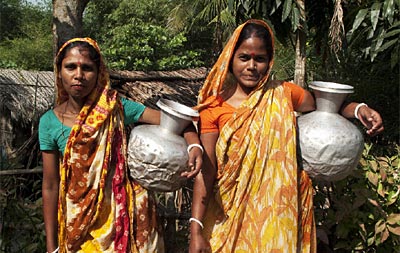Riders on the Storm
One of the sure results of climate chaos in the Himalayas and irresponsible engineering on Tibet's rivers will be refugees—millions of them. India is constructing a barbed-wire barrier all along its border with Bangladesh—to prevent climate change refugees crossing into Indian territory. So who will take the refugees? It could become the moral dilemma of the 21st century.
Another huge issue concerns water justice and the right to clean water sources. This involves several important principles: the sharing of transboundary rivers between several nations, and prevention of pollution at the headwaters of major rivers to ensure a supply of clean water downstream. UN guidelines for transboundary rivers state that river resources are to be shared. China blatantly ignores this principle. China has never consulted lower riparian states before undertaking dam construction upstream, although dam-building is considered a trans-border water issue. China has not ratified the UN Convention on Non-Navigable Use of International Watercourses (1997). In rejecting this 1997 United Nations convention that lays down rules on shared water resources, Beijing asserted its claim that an upstream power has the right to assert absolute territorial sovereignty over the waters on its side of the international boundary — or the right to divert as much water as it wishes for its needs, irrespective of the effects on a downriver state. Today, by building megadams and reservoirs in its borderlands, China is working to re-engineer the flows of major rivers that are the lifeline of the nations downstream. China has resolutely refused to join the Mekong River Commission — set up in 1995 to resolve issues of shared concern by the countries along the Mekong. Burma has not joined the MRC either.
Shortfall in Bangladesh
Bangladesh is hot, flat and crowded. Rivers are lifelines for the 160 million people of Bangladesh—and they are all sourced in the Himalayas. A major artery from Tibet is the Tsangpo, which flows across Tibet, turns a sharp corner into India (where it is known as the Brahmaputra), and then on into Bangladesh, where it is called the Jamuna. With construction of dams on the Tsangpo in Tibet, and also on tributaries of the Brahmaputra in India, the flow of water into Bangladesh could be drastically altered. This water is relied upon heavily for irrigation in intense agriculture in Bangladesh. But this is not just a question of water—it is a question of blocking the movement of nutrient-rich sediment, which courses down from Tibet and creates islands of silt in Bangladesh. In addition, migration and spawning of fish would be interfered with due to dams—and fish provide a staple food for Bangladeshis. Without water, nutrient-rich sediment, and fish, the people of Bangladesh living on islands in the Jamuna (Brahmaputra) will become refugees.
On the brink of great climate change
Bangladeshi climate scientist Atiq Rahman calls it 'climate genocide'—referring to the potential disastrous flooding of Bangladesh, where large areas of the nation could simply disappear under water, due to rising sea-levels (due to climate change factors). He says Bangladesh is the ground zero of global warming. Quoted in a 2008 interview, he comments: 'From now on, we need to have a system where, for every 10,000 tonnes of carbon you emit, you have to take a Bangladeshi family to live with you. It is your responsibility.'
Shortfall in Cambodia
At the tailend of the Mekong, in Cambodia, lies a vast inland sea: Lake Tonle Sap. The lake is one of the world's largest freshwater fisheries, providing the staple food of Cambodia. It is estimated that Lake Tonle Sap contributes almost two-thirds of Cambodia's annual fish catch, largely comprising migratory fish species. The lake is heavily dependent on the ebb and flow of the Mekong: it is estimated that over 70 percent of the flow for Tonle Sap comes from the Mekong. There is an annual reversal of current into the Mekong from Lake Tonle Sap.
In the past decade, the fish catch at Lake Tonle Sap has dwindled significantly. Fingers are being pointed at the four mega-dams started up on the Mekong in SW China. Another mega-dam project, financed and designed by a China Southern Power Grid Company, is slated to be built close to Kratie in NE Cambodia, on the Mekong. If this 2,600MW hydropower project goes ahead, you might as well kiss Lake Tonle Sap goodbye. Fish migration from southern Laos and beyond will disappear, causing fish stocks to collapse at Lake Tonle Sap.
